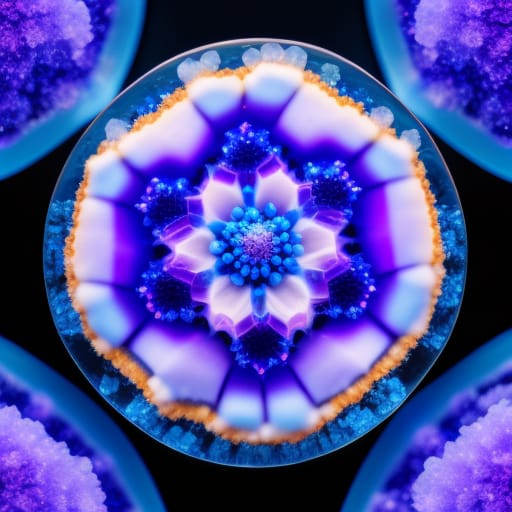Crystal growth is a complex science that requires careful control of many different factors. Even experienced researchers can run into problems with growing high-quality crystals. This guide will teach beginners the basics of troubleshooting common issues in crystal growth.

What is Crystal Growth?
Crystal growth refers to the process of forming a crystalline solid from atoms, molecules, or ions. This occurs through a phase change from gas, liquid, or solid to a perfect crystalline structure. Some key points about crystal growth:
- It is an active area of materials research used to produce crystals for electronics, optics, laser/radiation detection, and other applications.
- The process involves delicate control of temperature, pressure, impurities, and other factors.
- High-quality single crystals with minimal defects are desired for research and industry.
The goal of troubleshooting is to identify flaws in the growth process and improve crystal quality.
Common Factors Affecting Crystal Growth
There are several key parameters that must be carefully controlled to grow high-quality crystals:
Temperature
- The temperature must be within an optimal range for crystal growth to occur.
- Too low, and the mobility of atoms/molecules is reduced, inhibiting growth.
- Too high, and the crystal may melt or form defects.
- Precise temperature regulation is required for consistent crystal growth.
Supersaturation
- Supersaturation refers to the concentration of solute being higher than its solubility.
- High supersaturation promotes fast nucleation and growth.
- But too high leads to defects and poor quality.
- Low supersaturation causes slow growth.
- But too low results in no growth at all.
| Supersaturation Level | Effect |
|---|---|
| Low | Slow crystal growth |
| Optimal | Good crystal growth rate |
| High | Fast growth but more defects |
Nucleation
- Nucleation is the formation of a microscopic crystalline phase that serves as a seed for further growth.
- High nucleation rates can cause excessive, spontaneous formation of crystals.
- This depletes nutrients and results in small crystal size.
- Low nucleation causes few growth sites to form, inhibiting crystal growth.
Impurities
- Impurities like dust particles can get incorporated into the crystal structure during growth.
- Different kinds of impurities can:
- Distort the crystal lattice
- Change the growth rate
- Alter chemical properties
- Affect optical clarity
- High purity levels are required for high-quality crystals.
Morphology
- Morphology refers to the characteristic shapes and faceting of crystal surfaces.
- The morphology is affected by:
- Crystal structure
- Intermolecular forces
- Interactions with solvent
- Impurities
- An uneven morphology can inhibit growth and cause defects.
Techniques for Troubleshooting Crystal Growth
When problems arise in crystal growth, there are systematic methods to identify and correct the issue.
General Flowchart
This flowchart provides an overview of the troubleshooting process:
The key steps are:
- Characterize the issue – e.g. slow growth, defects
- Consider possible causes – temperature, supersaturation, etc
- Adjust parameters methodically – change one variable at a time
- Grow test crystals under new conditions
- Analyze results and repeat the process until the issue is resolved
Following this cycle systematically helps identify the root cause.
Solutions for Common Issues
Here are some typical problems and potential solutions:
Problem: Cloudy or opaque crystals
- Solution: Filter solutions for impurities, and ensure a dust-free environment. Optimize temperature to reduce defects.
Problem: Small crystal size
- Solution: Reduce supersaturation/nucleation rate. Also, try increasing temperature.
Problem: Distorted crystal habits
- Solution: Ensure optimal temperature. Filter for impurities. Consider additives to modify morphology.
Problem: Slow growth rates
- Solution: Increase supersaturation and temperature (within limits). Modify solvent interactions.
Bulk Crystal Growth Techniques
Different techniques are used to grow bulk crystals, each with pros and cons:
| Method | Description | Advantages | Disadvantages |
|---|---|---|---|
| Bridgman | Crystallization along a temperature gradient | Simple, produces large crystals | Temperature gradient defects |
| Czochralski | Large, high-quality single crystals | Simple, produce large crystals | Complex, high temperatures |
| Flux | Crystallization from molten solvent | Lower temperatures possible | Removal of solvent difficult |
| Hydrothermal | Crystallization from high T aqueous solutions | Can use lower temps, high pressures | Specialized equipment needed |
Understanding the fundamentals of each method helps troubleshoot issues.
Van der Waals Crystal Growth
Van der Waals crystals like graphene and boron nitride require specialized growth techniques. Common approaches include:
- Chemical vapor deposition (CVD) – crystals precipitate from gas phase
- Molecular beam epitaxy (MBE) – deposition from molecular beams in vacuum
- Mechanical exfoliation – splitting crystals from bulk materials
Defects can arise via temperature issues, impurities, substrate interactions, and strain.

Conducting Experimental Investigations
Additional experiments help provide insights into growth issues:
Characterization Techniques
- X-ray diffraction provides information about crystal structure.
- SEM imaging of morphology shows defects and imperfections.
- Optical microscopy to examine clarity.
- Chemical analysis like ICP-MS identifies impurities.
Research Studies
- Research systematic effects of variables like temperature, supersaturation, and solvents.
- Analyze nucleation, growth kinetics, and defect formation mechanisms.
- Investigate new methods like ultrasound, and magnetic fields.
- Model growth processes computationally.
Crystal Synthesis Exploration
- Test new chemical precursors and solvents.
- Explore the effects of adding inorganic compounds.
- Examine crystallization under flow conditions.
- Optimize delivery of nutrients over time.
By taking an investigative approach, new insights can be gained to explain crystal growth behavior.
Key Technical Aspects
There are some additional technical factors to consider when troubleshooting:
Grain Selectors
- Grain selectors filter out crystals not aligned in the desired direction.
- Important for producing high-quality single crystals.
- Issues can arise from poor selector calibration and crystal alignment.
Cleavage Planes
- Cleavage describes how a crystal fractures along definite planes.
- Cleavage patterns depend on the crystal structure.
- Problem cleavages can make crystal processing difficult.
Phase Diagrams
- Phase diagrams show the stable phases under different conditions.
- Useful for identifying optimal temperature, and pressure ranges.
- Incongruently melting materials have more complex diagrams.
Proper control of these technical factors helps avoid downstream issues.
Experts at Oak Ridge National Lab
Oak Ridge National Laboratory (ORNL) is a leading research center with extensive expertise in crystal growth:
- Specialized in the growth of scintillator crystals for radiation detection.
- Develop innovative growth systems like laser-heated pedestal growth.
- Staff scientists investigate crystal growth kinetics, modeling, and characterization.
- State-of-the-art facilities for bulk crystal growth and nanomaterials.
Connecting with ORNL scientists can provide valuable mentorship on crystal growth challenges.
Prominent Researcher: Dr. Zhen-yu Zhang
Dr. Zhen-yu Zhang is a professor at Zhejiang University known for his advances in crystal growth:
- Expertise in inorganic nonlinear optical crystals.
- Developed new techniques like solid-liquid interfacial diffusion.
- Elucidated mechanisms of defect formation.
- Authored over 130 papers on crystal growth and characterization.
- Serves as editor for multiple scientific journals.
Collaborating with leading researchers like Dr. Zhang can bring new perspectives to troubleshooting problems.

Science Fair Project Ideas
For a student interested in crystal growth, here are some potential science fair projects:
- Test effects of temperature, cooling rate, and solution concentrations on alum crystal size.
- Grow borax crystals with different impurities and compare properties.
- Determine optimal conditions for homemade rock candy crystals.
- Investigate how adding cornstarch affects crystal shapes.
- Engineer a creative crystal growth chamber with temperature control.
Science fairs allow hands-on learning about variables controlling crystal quality.
Conclusion
- Crystal growth is a complex process that is highly sensitive to many different factors. Careful control is required to achieve flawless crystals.
- When problems occur, take a systematic, investigative approach.GetMethodically adjust parameters and analyze results.
- Leverage tools like phase diagrams, grain selectors, and external experts. Characterization and focused experiments also provide insights.
- With patience and persistence, the root causes of crystal growth issues can be uncovered. This troubleshooting knowledge will lead to higher-quality results.
The troubleshooting techniques covered in this guide provide a solid starting point for anyone new to crystal growth research or education. Remember – do not get discouraged by initial setbacks. Troubleshooting is a critical scientific skill that develops over time with experience. With the right systematic approach, those flawless crystals are within reach.
Additional Resources
- Introduction to Crystal Growth and Characterization – Textbook by Kuech and Banerjee
- Handbook of Crystal Growth – Comprehensive reference work
- Crystal Growth Technology – Book by K. Byrappa and T. Ohachi
- Crystal Growth for Beginners – Fundamentals guide by Kashinath et al.
- Journal of Crystal Growth – Leading publication on crystal growth research
Frequently Asked Questions
What are some common problems in crystal growth?
Some frequent issues are cloudy or opaque crystals, small crystal size, distorted crystal habits, slow growth rates, and excessive nucleation. These problems arise from suboptimal control of factors like temperature, supersaturation, impurities, and morphology.
How can I determine the best temperature for crystal growth?
The optimal temperature range depends on the material. Using a phase diagram helps identify suitable temperatures where the crystalline solid is stable. Beyond this range, growth may be inhibited or defects introduced. Experiment with different temperatures while keeping other factors constant to find the ideal temperature for quality crystal growth.
What techniques allow the characterization and analysis of crystal defects?
Techniques like X-ray diffraction, SEM, and optical microscopy can reveal imperfections and flaws in crystal structure and morphology. Chemical analysis using ICP-MS can detect impurities that cause defects. Studying cleaved crystal surfaces and etching with chemical reagents also exposes defects for microscopy.
How can I optimize crystal shape and morphology?
Morphology is sensitive to factors like temperature, solvents, impurities, and additive compounds. Systematically vary these parameters and analyze the impact on crystal faceting. Matching synthetic conditions to the way the material crystallizes naturally also improves morphology.
Why is it important to filter solutions for impurities?
Even tiny amounts of dust or other particulate matter can get embedded into the lattice, creating defects. Suspended particles also provide nucleation sites, causing excessive spontaneous crystallization. Ensuring high-purity input materials and filtering solutions helps reduce impurities that impact crystal quality.